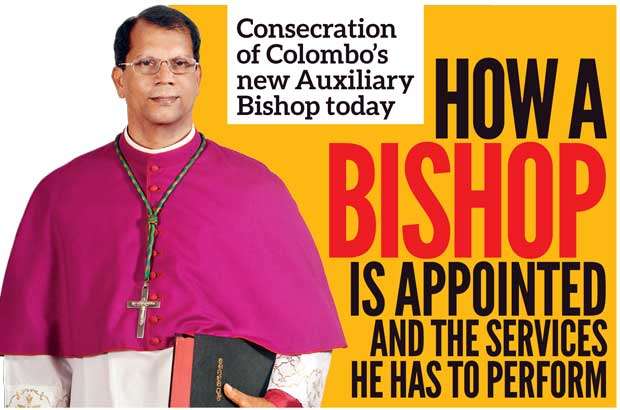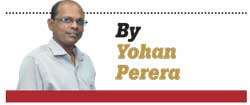23 Jun 2018 - {{hitsCtrl.values.hits}}

 The Catholic Church in Sri Lanka celebrates the ordination of a new Auxiliary Bishop of Colombo Rt. Rev. Jayakody Aratchige Don Anton Jayakody today, June 23 at St. Lucia’s Cathedral, Colombo.
The Catholic Church in Sri Lanka celebrates the ordination of a new Auxiliary Bishop of Colombo Rt. Rev. Jayakody Aratchige Don Anton Jayakody today, June 23 at St. Lucia’s Cathedral, Colombo.
Rev. Fr Edmund Tilakaratne, Director Social Communication Centre of Archdiocese of Colombo, spoke to on the event and outlined the history of the Catholic Church in Sri Lanka. He also explained in length how a bishop is appointed and the functions a bishop has to perform.
How a Bishop is appointed and his main functions
As Fr. Tilakaratne explained priests are asked to write about whom they think should be appointed as a bishop. They are asked to write secretly. The next step would be to select the top three whom priests have named and written about. The names of the selected three are then handed over to the Apostolic Nuncio (Ambassador of the Vatican). The three names are then sent to Rome for the Vatican to consider. Many discussions and consultations take place at this stage. The Cardinal if available or the Archbishop of an archdiocese in the said area is consulted in the case of appointing an auxiliary bishop. In the case of appointing a bishop the outgoing bishop is consulted if necessary. Elders of the church in Rome then select a priest whom they think is best suited for the job naming him number one. The remaining two are named number two and three.
Bishop Jayakody will fill the vacancy created by the resignation of Bishop Marius. Bishop Emmanuel Fernando was catering to the needs of the Tamil flock in the archdiocese
All three names are then handed over to the Pope who makes the final decision. According to Fr. Tilakaratne the Pope has the final say. He could name the priest chosen for the number one spot or even appoint priests who have been chosen as number 2 or three as the Bishop or the auxiliary.
Usually auxiliaries are appointed to an archdiocese. An area is declared as an archdiocese if there is a high population of Catholics. Sometimes the geographical extent is also considered. Colombo is the only archdiocese in Sri Lanka. About 50 percent of Sri Lanka’s Catholics live in Colombo. There are several archdioceses in bigger countries.
“Bishops are usually considered a position with fullness of priesthood,” Fr Tilakaratne said. However this does not mean that priests are half baked. Bishops have specific functions while priests help the bishops in carrying out their functions. A bishop has the power to ordain a priest or a deacon. They have the power to give specific sacraments which are considered divine gifts, such as confirmation.
An Auxiliary Bishop helps a bishop to carry out his work in an archdiocese.
One can also say that a bishop has three main functions to perform. These include shepherding the flock, sanctifying (making the flock holy) and governing the church.
About the auxiliary bishop elect
Bishop-Elect Rt. Rev. Anton Jayakody was born on October 2, 1958 in Pamunugma in the Archdiocese of Colombo. He entered the St Aloysius minor seminary in 1975 after completing his studies at St. Joseph’s Roman Catholic School and at Gonsalves College.
Fr Jayakody entered the National Seminary, Ampitiya, Kandy in 1978 where he studied philosophy and theology. He was ordained a priest in Colombo on July 27, 1985. He was a member of the staff of the Intermediate Seminary, Kalutara, and served as a Parish Priest of Wewala, Pannipitiya, Halpe, and Welivita. He obtained his Licenciate in Philosophy at the Pontifical Urbaniana
University in Rome.
He held the post of Bursar and Formator at the National Seminary, Kandy. He was also Director Philosophate at the National Seminary, Kandy, and thereafter appointed as the Rector of Ampitiya National Seminary, from 2005–2011. From 2011 to date, he has been the Episcopal Vicar for Priestly Formation and Promotion of Vocations of the Archdiocese of Colombo, while being the Rector of St. John Mary Vianney Major Seminary, Colombo.
There were a few Franciscans including a parish priest by the name of João Vaz Monteiro in Colombo.
Future of the Colombo Archdiocese
Colombo archdiocese is headed by Archbishop Malcolm Cardinal Ranjith. There were three auxiliaries in the archdiocese during recent times. They were Rt. Rev Marius Peiris, Rt. Rev. Emmanuel Fernando and Rt. Rev. Maxwell Silva. Bishop Marius according to Fr. Tilakaratne resigned recently due to ill health. Bishop Jayakody will fill the vacancy created by the resignation of Bishop Marius. Bishop Emmanuel Fernando was catering to the needs of the Tamil flock in the archdiocese. However he was appointed as the Bishop of Mannar recently. Therefore Colombo Archdiocese might get another auxiliary in the future.
History of Catholism in SL, Colombo archdiocese and its Bishops
There is evidence that traders from Persia and South India brought Christianity to Sri Lanka prior to the 16th century. The Persian cross excavated in Anuradhapura belonging to the 5th century and the decorative baptismal pond excavated near Vavuniya proves the presence of Christians in Sri Lanka during the early period of the Anuradhapura Kingdom. A cross excavated from Anuradhapura in 1913 has been reportedly identical to the cross found at St Thomas’ Mount near Chennai. However Christianity has spread on a large scale during the time of the Portuguese who accidently arrived in Sri Lanka on November 15, 1505.
Sri Lanka had a Tamil kingdom in the north and in the south there were two Sinhalese kingdoms, one in the central highlands with Kandy as its capital, and the other, comprising mainly of the south-western lowlands, at the time Portuguese arrived in the island according to the Mahawansa. The South Western region was the largest, richest and most powerful. The ruler of this region, King Dharma Parakramabahu IX was considered as the ruler of the whole country and resided in his capital, Kotte. Portuguese with the permission of King Dharma Parakramabahu IX built a small chapel in Colombo. Franciscan Friar Vicente, the chaplain of the fleet, celebrated Mass in that chapel. With the Portuguese influence in Kotte becoming stronger with time, the religion slowly began to spread among the local inhabitants. After access to the country was made easier for the Portuguese through construction of a fort in Colombo, Franciscan missionaries were also sent to
Sri Lanka. There were a few Franciscans including a parish priest by the name of João Vaz Monteiro in Colombo. His engraved tombstone was discovered in Colombo in 1836. Towards the end of the year 1543, five Franciscans were sent from Portugal to preach here. This was the time missionary St Francis Xavier himself arrived in India. Stories of Xavier’s work in South India reached the shores of the island of Mannar in the North West coast of Sri Lanka. Due to the pleading of the people there, Xavier, unable to go himself, sent a fellow missionary to Mannar who converted hundreds of locals, thus spreading the faith in the North of the country. Catholic faith grew in the country since then. King Dharmapala succeeded to the throne in 1551 and thus became a Catholic.
Franciscan missionaries made a great headway in their evangelization work in Kotte and Jaffna. The Catholic faith spread further when other religious orders such as the Jesuits, Dominicans and Augustinians, arrived in the country as well. The Jesuits arrived in 1602, the Dominicans in 1605, and the Augustinians in 1606. Catholicism took to the back seat with the arrival of the Dutch later in the 17th century, who prohibited Catholicism and gave predominance to their Protestant faith founded by John Calvin. Many Catholics were persecuted. An Indian priest from Goa, Fr. Joseph Vaz, upon hearing of the plight of Sri Lankan Catholics, came to the island in disguise in 1687 and secretly ministered to the Catholics. Later other Indian priests from the Oratory of Goa joined him. They were kindly treated by the Sinhalese Buddhist Kings of Kandy. Fr. Vaz served the church in Sri Lanka to his death in 1711 and is venerated as the Apostle of Sri Lanka. He was beatified by Pope John Paul II in 1995 and was canonized by Pope Francis who visited Sri Lanka in 2015. Throughout the Dutch period, up to 1796, it was these Indian Oratorians, who looked after the Church in Sri Lanka.
Later after the Dutch left the island with the arrival of the British, various orders were sent to Sri Lanka. These included Oblates of Mary Immaculate from France, Sylvestro Benedictines from Italy, and Jesuits from Belgium. Several women’s religious orders also began educational and social work. Most importantly, steps were taken to train Sri Lankan candidates for Priesthood and Religious life. Sri Lanka was established as a part of the diocese of Cochin, India during this period up to 1845. Colombo was created a diocese on February 17, 1845. Colombo was elevated to the rank of a metropolitan archdiocese in 1886-87. Anuradhapura, Badulla, Batticaloa, Chilaw, Galle, Jaffna, Kandy, Kurunegala, Mannar, Ratnapura, and Trincomalee were named as dioceses later. A French oblate Christopher Bonjean, became the first Archbishop of Colombo in 1886. Pope Pius XII named the archdiocese ‘Archdiocese of Colombo in Ceylon’ on December 6, 1944, but was simplified to ‘The Archdiocese of Colombo’ on May 22, 1972 by Pope Paul VI. The first Sri Lankan Archbishop, Thomas Benjamin Cooray was appointed in 1947, and in 1965 he also became the first Sri Lankan Cardinal. He retired in 1978 and thus Bishop Nicolas Marcus Fernando succeeded him as the new Archbishop of Colombo. Bishop Oswald Gomis succeed him as the Archbishop of Colombo in 2002 and served till 2009. The current Archbishop of Colombo, appointed by Pope Benedict XVI on June 16, 2009 was appointed cardinal in 2010.
01 Jan 2025 17 minute ago
01 Jan 2025 36 minute ago
01 Jan 2025 49 minute ago
01 Jan 2025 1 hours ago
01 Jan 2025 2 hours ago